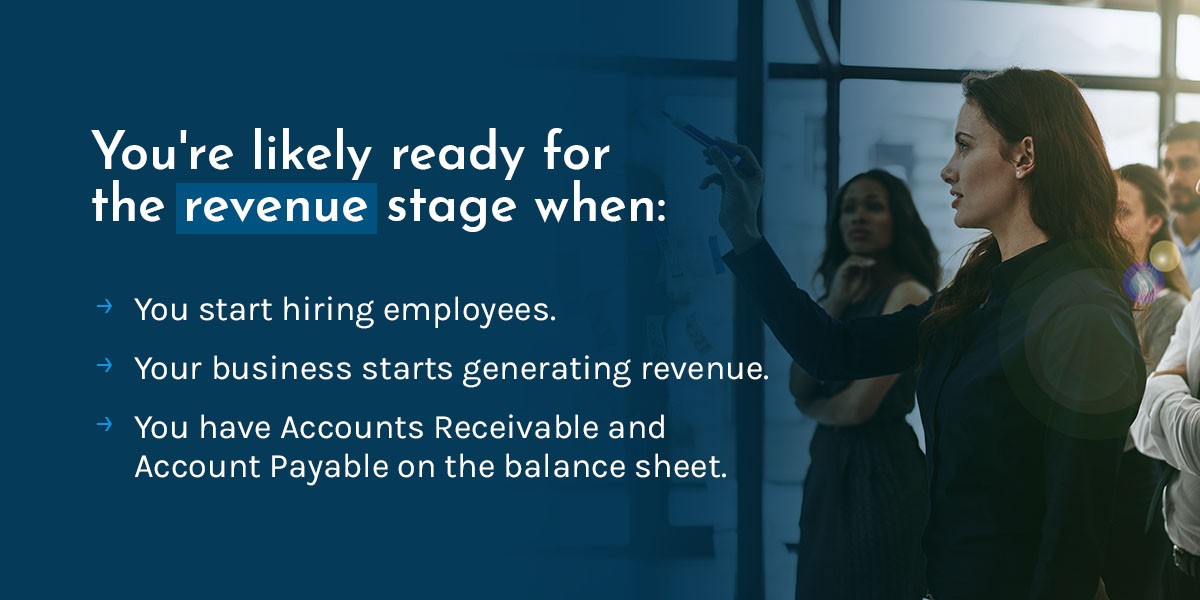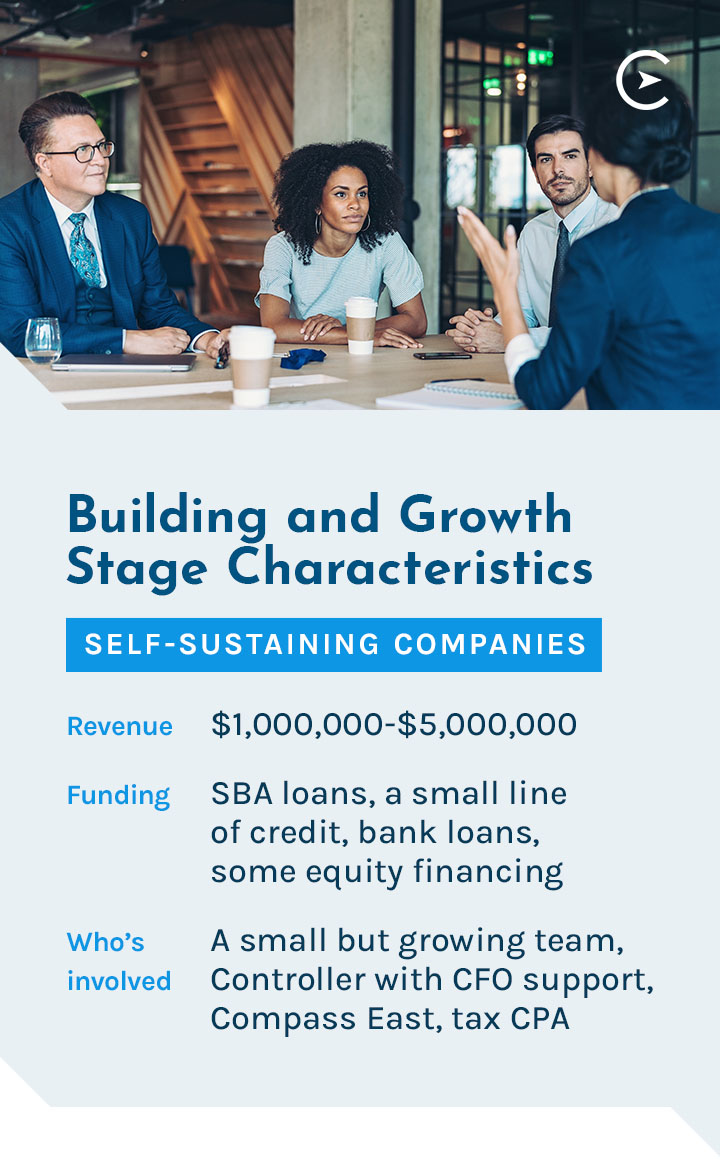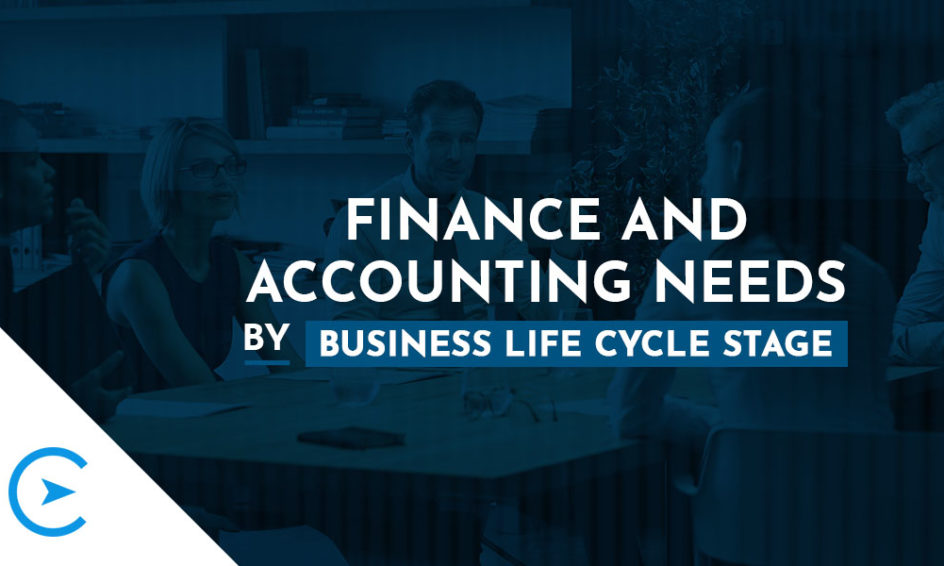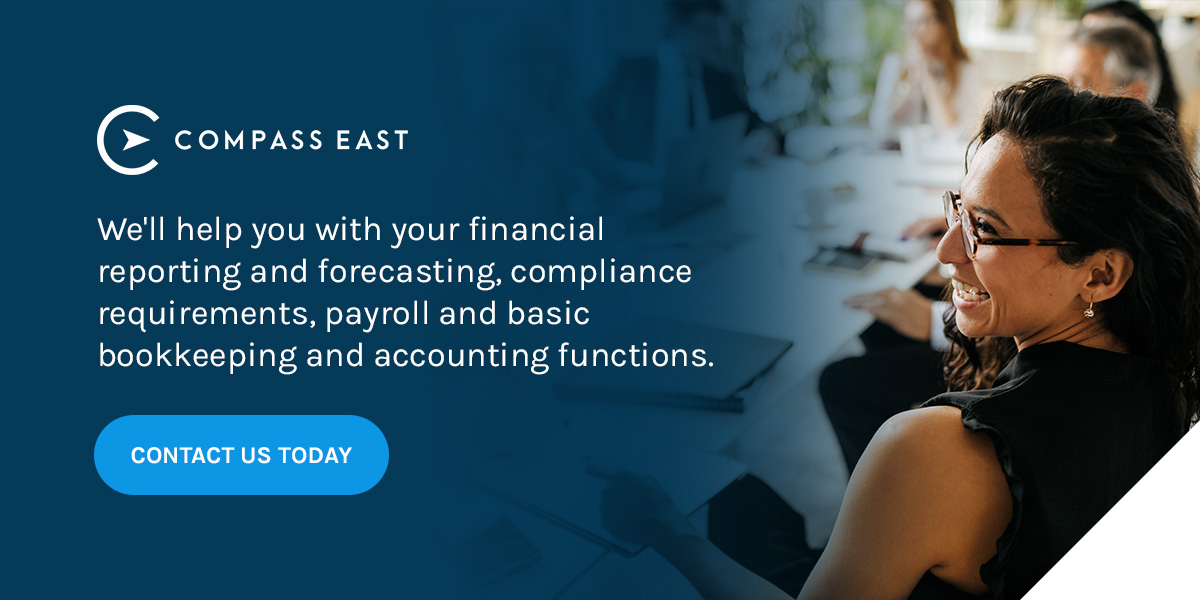When it comes to growth, every company is different. A venture-backed startup might want to scale and grow quickly in awareness of a large cash burn in order to quickly capture market share. Another business may want to create a sound cash-flow positive business that can support their lifestyle and family. And, other businesses can fall somewhere in between.
While companies grow at different rates with different strategic outcomes and goals in mind, they share a common pain when it comes to finance and accounting operations. Needs and approaches are different, but every company needs clarity in its financial reporting capabilities to make strategic decisions. In our experience working with hundreds of high-growth businesses, we find that companies will find themselves in five distinct stages at some point in their business lifecycle.
What phase of growth do you find yourself? How should you be thinking about current and long-term finance and accounting needs? Let’s take a closer look at the five stages of a company’s lifecycle to understand your business’s journey through finance and accounting needs at each stage.
1. Startup Stage Finance and Accounting
The startup stage is the first stage and the beginning of your business’s life cycle. At this point, you’re probably on your own or working with a small team. Your revenue is usually under $500,000, and your approach to finance and accounting is likely “Do It Yourself”.
A million things are going on during the startup stage. Early-stage founders are focused on proving product-market fit, building a team, and survival! Typically they are trying to answer:
- What is my value proposition?
- Who are my customers?
- Is this going to work?
Whether you’re going it alone or working with a support team, you’re probably wearing several different hats during this stage. You’re the founder, CEO, human resources, sales, operations and marketing team all rolled into one.
As your business’s expenses and income grow, it’s essential to keep track of what’s coming in and what’s going out. In the startup stage, you might try to teach yourself some accounting basics or use accounting software like Quickbooks Online. While you can handle some basic bookkeeping yourself in this earliest business stage, we recommend hiring a certified public accountant (CPA) to file your business taxes at the end of the year.
Startup Stage Characteristics
Businesses, especially those focused on Software as a Service or e-commerce, often share the following characteristics in this stage:
- Revenue: Pre-Revenue or first dollars, usually under $500,000
- Funding: Bootstrapped, personal funds, friends and family, pre-seed capital
- Who’s involved: Founder, early team, CPA
- Systems used: Quickbooks Online, personal credit cards, and bank accounts
- Biggest pain points: At this stage, your biggest pain points are limited time and money. While you might struggle to find time to do everything yourself, it may also be a challenge to find the funds to hire help. Typically books are going to be messy, financial reporting is almost non-existent, and any forecasts or financial models are going to be mostly theoretical. Not a lot of clarity in the financials. Cash basis accounting.
- Best tip: Take the time to build a structured Chart of Accounts, even if you don’t have a lot of activity yet. If you take the time to create a clean COA that fits your business, it will pay dividends down the road and you won’t have to completely revamp everything as things get more complex.
Signs You’re Ready to Move to the Next Stage
You’re likely ready for the next stage when:
- You start hiring a team of employees.
- Your business starts generating consistent revenue with active contracts from multiple customers.
- Cash basis accounting is blocking your ability to develop clean margins, metrics, and KPIs.

2. Revenue Stage Finance and Accounting
In this second stage of the revenue-based phase, you’re “officially” a growing business. You have customers. You may have framed the first dollar your company made, and you’re starting to see some early revenue traction.
You’re also starting to see the mix of benefits and challenges that customers can create at this stage. You need to fulfill contractual obligations with your customers to keep them happy and coming back for more. At the same time, you need to manage customer payments and accounts receivable and ensure that your clients pay on time so that you can pay your employees as well.
Some companies are still largely self-funded during the revenue stage, though you may be attracting attention and financing from angel and seed investors at this point. Opening a business line of credit or qualifying for a Small Business Administration (SBA) loan might also be an option for increasing your funding at this stage.
As the founder and owner, you’re likely deeply involved in your business’s finances during the revenue stage. As your resources increase during this stage, it’s also a good time to hire a company to handle payroll and a part-time bookkeeping firm. Your bookkeeper can focus on keeping your accounting records clean as possible and reconciling your bank accounts.
Revenue Stage Characteristics
The following are typical characteristics of businesses in the revenue stage:
- Revenue: ~$0-$1,000,000
- Funding: Bootstrapping, angels and angel groups, line of credit, SBA loans
- Who’s involved: Tax CPA, in-house or outsourced bookkeeper, founder
- Systems used: Quickbooks Online, Bill.com, Expensify, Divvy, Gusto
- Biggest pain points: At this stage, the biggest pain points are managing cash flow, accounts receivable and collections, and payroll. Founders are typically still very involved in the books and monitoring bank accounts, but still don’t have a lot of visibility into business performance. Need to get from cash to accrual basis.
- Best Tip: Create a detailed contract management tool early on that identifies the terms of each contract. The reality of this stage is that you will be testing pricing structures and contract terms, which creates accounting headaches down the road when it comes to revenue recognition. If you start tracking things early, cleanup will be easier down the road when you need to recognize revenue in appropriate periods based on contract structures and terms.
Signs You’re Ready to Move to the Next Stage
You may be moving to the next stage when:
- You have monthly financials but are unsure what they mean for your business.
- Your bank, investors, board of directors, or advisors are pushing you to level up your process.
- You need to fundraise.
- You aren’t sure how much money is moving in and out of the business monthly.
- You feel like you can’t get in front of things and build long-term growth strategies.
- The founders are standing in the way of financial operations.
3. Build Stage Finance and Accounting
Congratulations! Whatever you’re doing, it’s working and your company is growing. Your revenue has crossed the million-dollar mark, and your company is now entering the first stage of the growth-based phase. As you begin the build stage, your focus is on building strong foundations for your growing business.
Companies in the build stage usually transition from being owner led to building management layers and growing teams. It’s time to start delegating tasks and elevating responsibilities within your company, starting with professionalizing your finance and accounting operations. As the founder moves away from being directly involved in every activity, financial reporting and visibility become crucial in making strategic decisions.
You’re likely to be under more pressure to provide updates and financial reports at this stage. You’ll want to adopt a more robust technology stack to manage your cash and perform forecasting actively. You can also hire a CPA for taxes and a company like Compass East to manage financial operations, build cash forecasts, financial models, and dashboards for key performance indicators (KPIs).
At this stage, you’ll decide (if you haven’t already) which route your business will follow. Depending on which direction you take, you start to have differing F&A needs:
- You can be a self-sustaining business, anticipating annual growth between 5% and 50%.
- You can be a company aiming for exponential growth, with goals of 100%+ per year. In this case, you will need to find a form of venture or private-equity capital to help fund that growth.
Build Stage Characteristics of Self-Sustaining Companies
Self-funded companies in the build stage often share the following characteristics:

- Revenue: ~$1,000,000-$5,000,000
- Funding: SBA loans, lines of credit, bank loans, debt financing, some equity financing and growth capital
- Who’s involved: A growing internal team in multiple departments, outsourced finance and accounting like Compass East, tax CPA and advisors
- Systems introduced: Jirav, Fathom (Reporting Intelligence and Forecasting), Maxio
- Biggest Pain Points: The biggest pain points at this stage are generally creating accurate, relevant, and timely financial reports and building lagging KPI dashboards to measure business success. You will likely also have to deal with advisory board and bank reporting, financial modeling, and revenue recognition.
- Best Tip: Ensure a firm has reviewed and cleaned up the books. Focus on resetting the chart of accounts, moving from cash to accrual accounting, and developing good habits of closing books on a monthly basis. Data accuracy is typically the major problem for companies at this stage. Focusing on developing good habits now, will pay dividends when you need to raise bank debt or start exploring acquisitions and an exit down the road.
Build Stage Characteristics of PE and VC-Backed Companies
Private Equity and Venture Capital-backed companies in this stage tend to have the following characteristics:
- Revenue: Up to $10,000,000
- Funding: Venture and Private equity investors (typically a Series A occurs in this stage), Accounts Receivable and Asset-Based Lending or recurring revenue-based financing
- Who’s involved: An internal foundational team, potentially a VP of Finance, Outsourced Controller services like Compass East, tax CPA and advisors
- Systems introduced: Jirav, Maxio, Carta
- Biggest Pain Points: At this stage the company is in hypergrowth mode. You’ve raised significant capital to quickly ramp up operations, sales, and the team. Revenue recognition is a major pain point as you’ve tested out lots of different contract structures. You need to set up and manage lots of software systems and make sure people are using them appropriately. Systems needs to work together in the right ways to ensure data is accurate for efficient reporting.
- Best Tip: For software/recurring revenue businesses, using contract management and revenue recognition tool like Maxio greatly decreases the pain when it comes to invoicing, managing collections, keeping track of renewals, and calculating revenue KPIs for your investors. You have to recognize revenue in the appropriate periods to produce accurate gross margins and KPIs.
Signs You’re Ready to Move to the Next Stage
You’re typically ready to move to the next stage when:
- You feel pressure from the board and investors for faster and more frequent financial reporting.
- You need to build cash forecasts and perform scenario analysis to make short and long-term decisions.
- The need for a CFO is becoming more apparent as the need for outside finance and accounting support increases.
- The business model has become much more complex with multiple streams of revenue and various business divisions.
4. Scale Stage Finance and Accounting
In the next growth phase, the complexity of the business has increased. The team has grown. You probably are approaching over 50+ people and management layers must be installed in order to sustain growth.
Your company’s scale stage will look different depending on whether you’ve chosen to be self-sustaining or investor-backed, though there are some similarities. In either case, you’ll need to have enough financing to cover the cost of increased growth at this point. You’ll also need to invest in technology and focus on scaling up your finance and accounting function.
Scale Stage Characteristics of Self-Sustaining Companies
You can often identify self-sustaining companies in the scale stage by the following characteristics:
- Revenue: $5,000,000-$25,000,000
- Funding: Growth equity, bank loans, lines of credit, alternative funding
- Focus: Growing through acquisition and location or product line expansion
- Who’s involved: CFO (Fractional, Interim or In-house), VP of Finance, Outsourced Controller, finance & accounting team
- Systems introduced: Integration of F&A stack with other systems in the business (i.e. CRM, ERPs, etc)
- Biggest pain points: At this stage, you’ll likely find a need for a strong Controller function with the support of a CFO, VP of Finance or strategic business advisor. You’ll need to emphasize using leading KPIs to build an internal culture of accountability to the financials. You should set goals connected to lagging indicators and financial results and work to connect people and products to long-lasting profit.
- Best Tip: Develop and track performance-enhancing KPIs and identify key drivers in the business. If the plan is to ultimately exit the business, you can measure and track the valuation metrics of the company over time. When the time comes, you are in a much better position data-wise to maximize that valuation.
Scale Stage Characteristics of PE-Backed Companies
Investor-backed companies in the scale stage often have the following characteristics:
- Revenue: $10,000,000-$25,000,000
- Funding: Private equity and Venture capital investors, up to $25,000,000+ in raised capital, Later-stage capital investors
- Focus: Building a scalable business, simplifying roles in the company, M&A activity to grow, building employee stock programs to recruit talent
- Who’s involved: CFO (Fraction, Interim or In-house), an Internal VP of Finance, with a strong internal or external accounting team that can appropriately scale as your business grows
- Systems used: Integration of F&A stack with other systems in the business (i.e. CRM, ERPs, etc); or custom-built internal software to further enable your business growth
- Biggest pain points: The biggest pain points for investor-backed companies include emphasizing clean and quality board reporting and connecting leading KPIs to lagging financial metrics for optimal business intelligence.
- Biggest Tip: It’s likely time to begin bringing some finance operations in-house. Some may choose to to bring the entire team in-house. Those with a good outsource F&A partner can combined this team with new internal team members for optimal scale and effectiveness in the business growth. You will also need to add strategic support in the form of CFO, VP of Finance and other strategic growth advisors.
Signs You’re Ready to Move to the Next Stage
You’re ready for the next stage when:
- Interest from potential buyers is starting to ramp up.
- You’re ready to focus on significant growth into an initial public offering (IPO).
- You have opportunities to exit the business.

5. Exit Stage Finance and Accounting
For high-growth firms, they may find themselves bouncing in and out of the various stages of the lifecycle in their journey. However, when you get to a solid point of scale, you may be thinking of how to either get to an exit or to maturation. At Compass East, we look at these two as one in the same.
If you have a business entering a maturation point, then it should be ready to exit at the most optimal point for the investors and owners as opportunities arise. In this stage, your company’s original grand visions are coming to fruition. It’s up to you to decide what to do next.
Some business owners choose to sell, others consider taking their company public with an IPO and some continue to focus on private, sustainable growth. Your company’s finance and accounting needs during the exit stage will depend on how to plan to continue the business.
If you plan on selling your company, you’ll want to focus on partnering with a strategic advisor who has experience with mergers and acquisitions. This could be in the form of a CFO that has experience in M&A and Investment Banking. Before you sell a business, however, you’ll need to have your financial statements organized so that the buyer can make sense of your company’s financial health.
Your finance and accounting needs will be slightly different if you plan on going public with your company. You’ll need a CFO with this public company experience to help get you to this level. It will also require auditors, investment bankers and other advisors to get to underwriting and prepare you for public company compliance. Due diligence in this process is significant. You will need a strong finance and accounting team to get you through this process.
If you want to remain at the helm of your mature company, you’ll need to invest in a full-time CFO, finance and accounting team to keep the wheels turning. This will include an internal accounting team that will ensure your business continues to operate smoothly and remains on the path of sustainable growth.
Small Business Maturity Characteristics
Mature small businesses whose owners want to remain often share these characteristics:
- Revenue: The company’s earnings before interest, taxes, depreciation and amortization (EBITDA) have crossed $1,000,000+.
- Funding: Debt and equity funding
- Focus: To continue on the path of sustainable growth, internally and privately
- Who’s involved: CFO with operational finance focus supported by a strong, fractional, external Controller team or internal accounting team
- Systems used: A complete enterprise resource planning system, either all in one or several integration items for an optimal ecosystem
- Biggest pain points: The biggest pain points at this stage may involve performing due diligence and dealing with investment bankers.
Value Exit Characteristics
Companies whose owners wish to sell often have the following characteristics:
- Revenue: While there is no perfect revenue number here, you will have sustainable revenue growth, scalable operations. Likely your R-Value is 40%+. (R-Value is also known as Rule of 40. It is the sum of your EBITDA Margin percentage and your revenue growth rate. Investors use this value as a key KPI to determine a long-term sustainable growth organization.)
- Funding: Private equity and strategic buyers
- Who’s involved: Strong team that is independent of the founding team, a CFO or other advisors with experience in exits, a strong accounting function internal or external with processes and systems that can easily transition to a new team in a sale
- Biggest pain points: The biggest pain points for owners looking to sell their company may involve performing due diligence, complex company structuring and financing, merger and acquisitions (M&A) negotiations and investment bankers.
IPO Characteristics
Companies that are ready for an IPO often have the following:
- Revenue: ~$50,000,000 and a healthy cash flow
- Funding: Public Markets
- Who’s involved: Corporate team, CFO with public-market experience and exposure to political aspects of public-market CFO roles, extensive accounting function with sufficient internal control throughout the company to ensure full regulatory compliance
- Biggest pain points: Companies planning to go public may face pain points involving complex company structuring and financing, performing due diligence, M&A negotiations and investment bankers.
Compass East Provides Finance and Accounting Functions for All Stages of Business Growth
As your business grows and changes, its finance and accounting needs will do the same. Compass East can provide your company with the team of experts it needs to reach its goals. We’re a team of CPAs and finance professionals that provides comprehensive finance and accounting services. We’ll help you with your financial reporting and forecasting, compliance requirements, payroll and basic bookkeeping and accounting functions.
Contact us today to learn more about our finance and accounting services and how we can help you, no matter where your business is in its life cycle.

